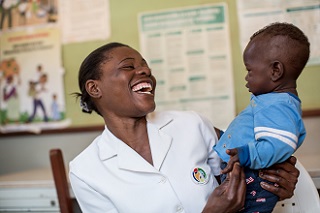New HIV infections among adolescents projected to rise by nearly 60 per cent by 2030 if progress stalls – UNICEF
Urgent action needed to improve HIV prevention and treatment for young people
New HIV infections among adolescents are projected to rise from 250,000 in 2015 to nearly 400,000 annually by 2030 if progress in reaching adolescents stalls, according to a new report released by UNICEF on December 1.

A Mothers 2 Mothers health worker at Mitundu Community Hospital in Malawi holds a baby who was tested and found not to have contracted HIV from his mother
“The world has made tremendous progress in the global effort to end AIDS, but the fight is far from over – especially for children and adolescents,” said UNICEF Executive Director Anthony Lake. “Every two minutes, another adolescent – most likely a girl – will be infected with HIV. If we want to end AIDS, we need to recapture the urgency this issue deserves -- and redouble our efforts to reach every child and every adolescent.”
AIDS remains a leading cause of death among adolescents, claiming the lives of 41,000 adolescents aged 10-19 in 2015, according to the 7th Stocktaking Report on Children and AIDS: For Every Child: End AIDS.
The report proposes strategies for accelerating progress in preventing HIV among adolescents and treating those who are already infected. These include:
• Investing in innovation including in locally grown solutions.
• Strengthening data collection.
• Ending gender discrimination including gender-based violence and countering stigma.
• Prioritising efforts to address adolescents’ vulnerabilities by providing combination prevention efforts including pre-exposure prophylaxis, cash transfers and comprehensive sexuality education.
Globally there were nearly 2 million adolescents aged 10 -19 living with HIV in 2015. In sub-Saharan Africa, the region most impacted by HIV, girls accounted for three out of every four new infections among adolescents aged 15-19.
Other findings in the report include:
• Remarkable progress has been made in preventing mother-to-child transmission of HIV. Globally, 1.6 million new infections among children were averted between 2000 and 2015.
• 1.1 million children, adolescents and women were newly infected in 2015.
• Children aged 0–4 living with HIV face the highest risk of AIDS-related deaths, compared with all other age groups, and they are often diagnosed and treated too late. Only half of the babies born to HIV-positive mothers receive an HIV test in their first two months, and the average age that treatment begins among children with vertically acquired HIV in sub-Saharan Africa is nearly 4 years old.
Despite progress in averting new infections and reducing deaths, funding for the AIDS response has declined since 2014, UNICEF said.
Source: United Nations Children's Fund
- 361 reads
Human Rights
Ringing FOWPAL’s Peace Bell for the World:Nobel Peace Prize Laureates’ Visions and Actions

Protecting the World’s Cultural Diversity for a Sustainable Future

The Peace Bell Resonates at the 27th Eurasian Economic Summit

Declaration of World Day of the Power of Hope Endorsed by People in 158 Nations

Puppet Show I International Friendship Day 2020

